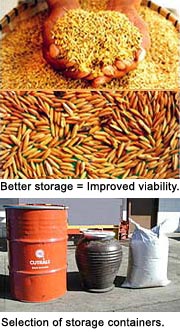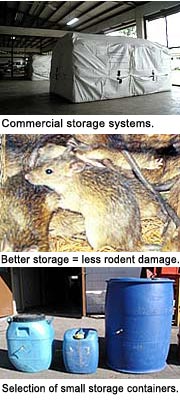Hermetically sealed systems
 What is hermetically sealed storage?
What is hermetically sealed storage?
Hermetically sealed storage involves putting grain into sealed containers that stop the movement of air (oxygen) and moisture between the outside atmosphere and the stored grain. The system can use special plastic containers (such as the volcanic cube and grain cocoons) or smaller containers made of plastic or steel or even clay water pots. The size of the systems can range from 25 litres to 300 metric tons. The system can be used for paddy, milled rice, and other cereal crops such as corn.
Why is sealed storage important?
- Hermetic storage improves grain quality and seed viability because it maintains the original grain moisture content and reduces pest damage (without the use of insecticides).
- Seed viability can be increased from 6 to 12 months in tropical environments.
- Sealed storage controls insects because the insects use the available oxygen during respiration and releases carbon dioxide (e.g., oxygen levels can be reduced from 21% to less than 5% within 10−21 days). At these low oxygen, insect activity is minimal and reproduction ceases.
- Rodents and birds do not appear to be attracted to the grain of these types of storage (possibly because they are unable to smell the grain).
How to use sealed storage?
- Grain and seed must be cleaned and dried to the desired target moisture content (e.g., 13% for storage of 8−12 months) before storing.
- Place the grain in a clean airtight container that can be completely sealed.
- Use grease or an airtight sealant (such as silicon) when closing the containers. With clay pots, paint both the inside and out with acrylic paint. If containers are not sealed properly oxygen leakage will occur and insect activity will increase.
- Place the container(s) in the shade or under cover.
- Limit opening and closing of the container(s).
Management issues
- Moisture movement can occur from the lower to upper levels in the larger systems if the system is not shaded or stored under cover.
- Intermittent opening and closing of the commercial storage systems replenishes oxygen levels inside the stored grain which may lead to the rapid re-infestation of insects such as the lesser grain borer (Rhizopertha dominica), these insects are capable of piercing the commercial plastic liner.
- If the smaller containers are not completely filled with grain, then there may be too much air relative to the amount of grain to reduce oxygen levels enough so as to control insects.
- Large commercial storages can be damaged by rodents. Plastic liners must be pulled tight and a clear space of 0.5 m kept around the containers.
- All recycled containers must be cleaned thoroughly before use.
Cost
The cost of a hermetic storage system depends on the size of the commercial storage or the cost of locally recycled containers and water vessels.
- The large commercial systems cost from $50−100 per ton capacity to purchase. With an expected life of at least 10 years this equates to a cost of approximately $5−10 per metric ton/year.
- The cost of locally constructed systems will depend on the purchase price of recycled containers or clay pots (200 liter oil drums often cost from $2−5).
For more information:
visit www.knowledgebank.irri.org. Email: postharvest@irri.org







